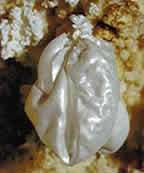Hydromagnesite
| Hydromagnesite | |
|---|---|
|
Hydromagnesite balloon in Jewel Cave | |
| General | |
| Category | Carbonate mineral |
| Formula (repeating unit) | Mg5(CO3)4(OH)2·4H2O |
| Strunz classification | 5.DA.05 |
| Dana classification | 16b.07.01.01 |
| Crystal system | Monoclinic |
| Crystal class |
Prismatic (2/m) H-M Symbol: (2/m) |
| Space group | P21/c |
| Identification | |
| Formula mass | 467.64 g/mol |
| Color | Colorless, white |
| Crystal habit | Acicular and as encrustations; pseudo-orthorhombic |
| Twinning | Polysynthetic lamellar on {100} |
| Cleavage | {010} Perfect, {100} Distinct |
| Fracture | Uneven |
| Tenacity | Brittle |
| Mohs scale hardness | 3.5 |
| Luster | Vitreous, silky, pearly, earthy |
| Streak | White |
| Diaphaneity | Transparent to translucent |
| Specific gravity | 2.16 - 2.2 |
| Optical properties | Biaxial (+) |
| Refractive index | nα = 1.523 nβ = 1.527 nγ = 1.545 |
| Birefringence | δ = 0.022 |
| Ultraviolet fluorescence | Fluorescent, short UV=green, long UV=bluish white. |
| References | [1][2][3] |
Hydromagnesite is a hydrated magnesium carbonate mineral with the formula Mg5(CO3)4(OH)2·4H2O.
It generally occurs associated with the weathering products of magnesium containing minerals such as serpentine or brucite. It occurs as incrustations and vein or fracture fillings in ultramafic rocks and serpentinites. It occurs in hydrothermally altered dolomite and marble. It commonly appears in caves as speleothems and "moonmilk", deposited from water that has seeped through magnesium rich rocks. It is the most common cave carbonate after calcite and aragonite.[1] It thermally decomposes,[4][5] over a temperature range of approximately 220 °C to 550 °C, releasing water and carbon dioxide leaving a magnesium oxide residue.
It was first described in 1836 for an occurrence in Hoboken, New Jersey.[2]
Stromatolites in an alkaline (pH greater than 9) freshwater lake (Salda Gölü) in southern Turkey are made of hydromagnesite precipitated by diatoms and cyanobacteria.[6]

Microbial deposition of hydromagnesite is also reported from playas in British Columbia.[8] The hydromagnesite-magnesite playas near Atlin, British Columbia are some of the most studied deposits of hydromagnesite. These deposits have been characterized in the context of a biogeochemical model for CO2 sequestration.[7]
One of the largest deposits of hydromagnesite exists in Greece.[9] It consists of a natural mixture with huntite. Local people have used the white mineral as a source of material for whitewashing buildings for centuries. In the mid 20th century the minerals, ground to a fine powder, found use as a filler for rubber shoe soles. The locals used the granite mills designed for grinding wheat. Commercial exploitation of the minerals began in the late 70s and early 80s with the mineral being exported worldwide. The Greek deposit is still operated commercially, although the world’s largest commercially operated reserves are in Turkey.
Uses
Its most common industrial use is as a mixture with huntite as a flame retardant or fire retardant additive for polymers.[10][11][12] Hydromagnesite decomposes endothermically,[4][5] giving off water and carbon dioxide, leaving a magnesium oxide residue. The initial decomposition begins at about 220 °C making it ideal for use as a filler in polymers and giving it certain advantages over the most commonly used fire retardant, aluminium hydroxide.[13]
Thermal decomposition
Hydromagnesite thermally decomposes in three stages releasing water and carbon dioxide.[4][5]
The first stage starting at about 220 °C, is the release of the four molecules of water of crystallisation. This is followed at about 330 °C by the decomposition of the hydroxide ion to a further molecule of water. Finally, at about 350 °C carbon dioxide begins to be released. The release of the carbon dioxide can be further broken down into two stages depending on the rate of heating.[5]
References
- 1 2 Handbook of Mineralogy
- 1 2 Webmineral data
- ↑ Mindat
- 1 2 3 Hollingbery, LA; Hull TR (2010). "The Thermal Decomposition of Huntite and Hydromagnesite - A Review". Thermochimica Acta. 509 (1-2): 1–11. doi:10.1016/j.tca.2010.06.012.
- 1 2 3 4 Hollingbery, LA; Hull TR (2012). "The Thermal Decomposition of Natural Mixtures of Huntite and Hydromagnesite". Thermochimica Acta. 528: 45–52. doi:10.1016/j.tca.2011.11.002.
- ↑ Braithwaite, C.; Zedef, Veysel (1996). "Living hydromagnesite stromatolites from Turkey". Sedimentary Geology. 106 (3-4): 309. Bibcode:1996SedG..106..309B. doi:10.1016/S0037-0738(96)00073-5.
- 1 2 Power, I.M.; Wilson, S.A.; Thom, J.M.; Dipple, G.M.; Gabites, J.E.; Southam, G. "The hydromagnesite playas of Atlin, British Columbia, Canada: A biogeochemical model for CO2 sequestration". Chemical Geology. 206: 302–316. doi:10.1016/j.chemgeo.2009.01.012.
- ↑ R. W. Renaut, Recent Mamgnesite-Hydromagnesite sedimesntation in Playa Basins of the Caribou Plateau, http://www.em.gov.bc.ca/DL/GSBPubs/GeoFldWk/1990/279-288-renaut.pdf British Columbia Geologic Survey
- ↑ Georgiades, GN (1996). "Huntite-hydromagnesite production and applications". Proceedings of the 12th Industrial Minerals Congress: 57–60.
- ↑ Hollingbery, LA; Hull TR (2010). "The Fire Retardant Behaviour of Huntite and Hydromagnesite - A Review". Polymer Degradation and Stability. 95 (12): 2213–2225. doi:10.1016/j.polymdegradstab.2010.08.019.
- ↑ Hollingbery, LA; Hull TR (2012). "The Fire Retardant Effects Huntite in Natural Mixtures with Hydromagnesite". Polymer Degradation and Stability. 97 (4): 504–512. doi:10.1016/j.polymdegradstab.2012.01.024.
- ↑ Hull, TR; Witlowski A; Hollingbery LA (2011). "Fire Retardant Action of Mineral Fillers". Polymer Degradation and Stability. 96 (8): 1462–1469. doi:10.1016/j.polymdegradstab.2011.05.006.
- ↑ Rothon. R., Particulate-Filled Polymer Composites, 2nd Edition, 2003
| Wikimedia Commons has media related to Hydromagnesite. |

